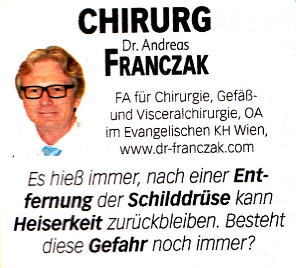Are you looking for goiter treatment or thyroidectomy?
Dr. med. Andreas Franczak (specialist in vascular surgery and visceral surgery) is your specialist in Vienna and skilled to treat multiple thyroid problems like goiter or thyroid nodules. Therefore, the most suitable treatment for your specific situation can be offered.
Ask which is best for you. You will quickly get an appointment.
Thyroid nodules & goiter – causes
The most common cause of enlarged thyroid disease (struma diffusa) is iodine deficiency. Due to insufficient iodine supply, more thyroid-stimulating hormone (TSH) is released. As a result, the thyroid is stimulated to grow, leading to thyroid enlargement (struma or goiter). This enlargement can lead to the formation of thyroid nodules (struma nodosa).
Thyroid nodules can also develop with sufficient iodine supply, mainly due to congenital factors. Approximately 15 to 30% of the adult population in Central Europe has thyroid nodules and/or struma (goiter).
Thyroid nodules – symptoms
Most goiters are benign. Often, they contain fluid accumulations (cysts). Only 0.1% of thyroid nodules are malignant. The enlargement of the thyroid can press on the airway and esophagus, causing the following symptoms:
- A feeling of pressure in the throat
- Swallowing difficulties
- Hoarseness
Other thyroid nodules symptoms can occur if hyperthyroidism (hyperfunction) develops. These symptoms are mainly hormonal, such as:
- Sleep disturbances
- Nervousness and increased sweating
- Menstruation disorders (dysmenorrhea)
- Weight loss
- Diarrhea
- Hair loss
What is a thyreoditis?
This refers to an inflammation of the thyroid. The following forms are distinguished:
- Acute thyroiditis: Very rare, caused by bacteria or fungi.
- Hashimoto's (chronic lymphocytic thyroiditis): Destruction by autoimmune processes. Here, Anti-TPO antibodies and thyreoglobulin antibodies are usually elevated. In thyroid nodules in Hashimoto's thyroiditis, an increased frequency of papillary carcinomas can be detected.
- Subacute thyroiditis (de Quervain): Often occurs following a viral respiratory infection and usually subsides spontaneously after few weeks.
- Riedel's thyroiditis (woody struma): Very rare.
Goiter – treatment & surgery
Which goiter treatment to choose depends on the type of struma. This can be determined using the following examinations:
- Ultrasound
- 99mTc Scintigraphy
- MiBi Scintigraphy
- FNA (Fine Needle Aspiration)
- Hormone status with calcitonin level
Depending on the results of these examinations, a goiter treatment is initiated or only controls are recommended. To rule out carcinoma, other symptoms such as growth tendency, evidence of enlarged lymph nodes, or hoarseness are also considered.
Goiter medication or radioiodine therapy
In the absence of suspicion of carcinoma, goiter medication or radioiodine therapy can be initiated to remove thyroid nodules.
- The LISA study showed that combined goiter treatment with iodide and L-thyroxine could reduce struma volume by 10% and thyroid nodule size by 21% after one year. Therefore, this therapy was more effective than the sole use of iodide or LT4.
- Die I-131 Radiojodtherapie kann sowohl bei nicht effektiver medikamentöser Therapie und als Ergänzung zur Schilddrüsenknoten-OP beim Karzinom eingesetzt werden. Zur Optimierung der ablativen Radiojodtherapie wird heute eine Stimulation von Thyreoglobulin mit rhTSH durchgeführt.
Thyroidectomy – goiter surgery
The extent of the thyroid nodule surgery depends on the nature of the disease. Often, surgeries are accompanied by medicinal, hormonal, and radiotherapeutic thyroid treatments:
- Solitary autonomous nodules: Often, the removal of these thyroid nodules is sufficient through a tiny skin incision.
- Struma nodosa: Today, complete removal of one side (hemithyroidectomy) or the entire thyroid (thyroidectomy) is usually performed.
- Graves' disease: This is an autoimmune disease with hyperthyroidism. If medical therapy is ineffective, radioiodine therapy or complete removal is indicated.
- In suitable cases, thyroidectomy can be performed using a minimally invasive (keyhole) technique.
- The condition-adapted use of neuromonitoring, especially continuous vagus nerve monitoring, reduces the risk of bilateral paralysis of the recurrent laryngeal nerve.
- In the case of carcinoma, a complete removal of the thyroid (total thyroidectomy) and possibly lymph node removal is usually indicated.
To protect the recurrent laryngeal nerves and parathyroid glands, neurostimulation and magnifying glasses are often used in addition to the surgery. The best surgical results are achieved by surgeons with extensive experience in thyroidectomies.
What types of thyroid carcinoma are known?
Most thyroid nodules are benign. Malignant thyroid carcinoma (malignoma) occur annually in 4 cases per 100,000 inhabitants and are the third most common tumor in women under the age of 40. The following types of thyroid carcinoma are distinguished:
- Follicular carcinoma (20-40%)
- Papillary carcinoma (50-70%)
- Undifferentiated (anaplastic carcinomas) about 5%
- Medullary (C-cell) carcinoma about 5% - this occurs in 15% as a familial form (MEN- multiple endocrine neoplasia)
The 10-year survival rates are: papillary: > 90%, follicular: >75%, medullary about 50%.
Autor: Dr. Andreas Franczak, Facharzt für Chirurgie, Gefässchirurgie und Visceralchirurgie
Thyroidectomy and goiter treatment in Vienna
Do you suffer from thyroid nodules symptoms? To remove thyroid nodules, there are several treatment methods.
Dr. med. Andreas Franczak is a specialist in Vienna and offers medicinal goiter treatments up to professional thyroidectomy. The practice can be found at Lazarettgasse 16-18 in 1090 Vienna. For quick and flexible appointment scheduling:

Mit dem Laden des Videos akzeptieren Sie die Datenschutzerklärung von YouTube.
Mehr erfahren

